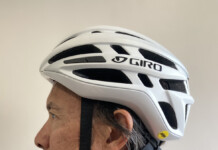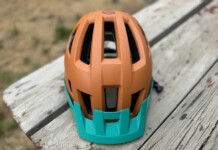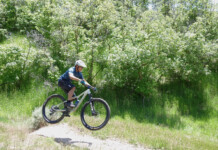By Tom Jow — Last month I explained some of the details about disc brakes for road bikes, one of the newest technologies for that category. There is another new development for road bikes worth discussing, electronic shifting. These new components have not only been in production for nearly five years, but have been in development for over twenty years.
The first attempt at electronic shifting was a front derailleur designed by Suntour and Browning in 1990. also during the 1990’s there were other unsuccessful attempts at electronic shifting by both Mavic and Sachs. It was not until 2009 that electronic shifting came back to the market. This time the manufacturer was Shimano and their DuraAce Di2 has become a big success with both the pro peloton and the public. Two years later Campagnolo upped the ante by not only offering electronic with an 11 speed cassette, but also in 3 group sets; Super Record EPS, Record EPS and Athena EPS. Shimano has since begun offering a second electronic group, Ultegra Di2. With each advancement in technology there are two questions: how does it work and why should I buy it?

The electronic shifting systems have all the same components as their mechanical plus two. One of them is a lightweight lithium-ion battery which powers all the components. There are two battery options. External, which can be used with both original equipment manufacturer (o.e.m.) internal wiring and external aftermarket installations or internal for o.e.m. internal wiring. The life of the battery on a full charge is estimated at one-thousand miles or more depending on shifting frequency. The second is a control box that distributes the signals from the shifters to the derailleurs as well as providing a mechanism to access the different operating modes including normal, adjust, battery indicator and diagnostics.
 The derailleurs look pretty standard except for the bulbous expansion which houses a small motor and microprocessor. The rear derailleur is really not that special outside of the fact it shifts much quicker and more precisely than a cable operated unit. The front derailleur, however, is special for two reasons. One, the electric motor provides a stronger and faster actuation than a mechanical unit. This, coupled with a stiff chain-ring set allow for faster shifts and the ability to shift under power. The second feature is the capability to sense the position of the chain on the cassette and adjust its position to prevent the chain from rubbing on the derailleur cage, automatically.
The derailleurs look pretty standard except for the bulbous expansion which houses a small motor and microprocessor. The rear derailleur is really not that special outside of the fact it shifts much quicker and more precisely than a cable operated unit. The front derailleur, however, is special for two reasons. One, the electric motor provides a stronger and faster actuation than a mechanical unit. This, coupled with a stiff chain-ring set allow for faster shifts and the ability to shift under power. The second feature is the capability to sense the position of the chain on the cassette and adjust its position to prevent the chain from rubbing on the derailleur cage, automatically.

The shifters, while looking the same, do not operate just like the standard units. Rather than being shifter levers, they are switches. This is one of the areas where the Shimano and Campagnolo are very different. The Shimano shifters essentially have buttons in place of moving levers. While this design does not offer a very tactile experience, removing the necessity of moving the lever over is a great benefit for riders with small or not very strong hands. Campagnolo on the other hand has chosen to retain a lever switch with a short throw. This feature can provide the rider with a little more positive feedback while shifting. Also, Campagnolo EPS has a multi-shift design that will shift the chain all the way up or down the cassette with one long depression of the switch (DuraAce Di2 2013 now has this feature), something no mechanical shifter can do.
It is pretty clear that electronic shifting systems have many advantages over mechanical systems. As with all new technology, it takes time to work the bugs out of the system and then to gain acceptance. The price then needs to come to a level where a larger number of users can afford it. The first two hurdles have been cleared as shown by the widespread use of Campagnolo EPS and Shimano Di2 not just in the pro peloton, but also by high end cyclists every where. The introduction of both Athena EPS and Ultegra Di2 shows that the price is coming closer to the recreational market. Electronic shifting is here to stay, this time.
Pros:
- Quicker, more precise shifting
- Can shift under power
- Readjustments are not necessary
- Reduced or zero lever throw (great for small hands)
- No front derailleur chain rub
- Multiple shifts are easier
- System firmware can be upgraded.
Cons:
- Slightly heavier
- Battery needs to be charged occasionally
- Increased cost over mechanical
- Firmware updates require PC
Got a bike question? Email Tom at 1tomjow@gmail.com.








Was this written in 2013? The article is ten years out of date!
Comments are closed.